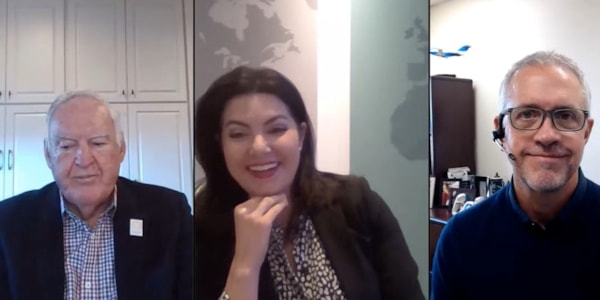Here is what we learned from the IADA Q4 market report

The International Aircraft Dealers Association held a webcast to discuss the 2022 fourth quarter.
On the panel were host Wayne Sterling the Executive Director of IADA, Zipporah Marmor the VP of Aircraft Transactions at ACASS and Chair on the IADA Board of Directors, and Phil Winters the VP of Aircraft Sales and Aircraft Management/Charter at Western Aircraft and the Vice-Chair on the IADA Board of Directors.
Sterling said that IADA members span the globe. Accredited IADA dealers make up roughly 15 percent of the world’s aircraft dealers but 48 percent of the world’s pre-owned sales. He said IADA takes up 50 percent of the dollar volume of pre-owned sales worldwide.
Marmor started by explaining how the data is obtained, through quarterly market surveys sent to members and dealers and from the monthly reports sent from IADA-accredited dealers. She said in Q4 2022, there was a 100 percent response rate from the 52 broker-dealer members of IADA.
Marmor then discussed, quarter by quarter, data for closed deals, new acquisition agreements and exclusive listings. The Q4 in 2022 was lower than in 2021, with 501 in Q4 2021 and a drop to 470 in Q4 2022. She said the market remains strong and active with a lot of deals. Marmor said the market seems a bit more settled than it did in 2021.
New acquisition agreements are trending slightly downward from 2021, compared with what has been retained to sell exclusively, which is up significantly from quarter to quarter. In the past 18 to 24 months, acquisition agreements surpassed listing agreements, which is not standard for the industry. Marmor said this is indicative of a return to a more normal market.

She said in 2021 and 2022, the hot topic was inventory, or a lack thereof. Despite the discussion of a lack of inventory, they were still record years and records sales, reflected in the numbers. While in the past, 40 percent of aircraft sales were on market and 60 percent off, in the last two years it was closer to 80 percent off or pre-market. With a return to more on-market aircraft, there is a longer sale window, normalizing the market.
Last year was one of the strongest years in history, a two percent increase over the previous year, which was also a record year. There were 1399 closed deals, compared to 1370 in 2021 and 1135 in 2020. New acquisition agreements remained relatively stable, with 688 new acquisition agreements reported in 2022, as opposed to 698 in 2021 and only 347 in 2020.
Winters discussed the quantitative data collected for the dealer activity report, with numbers for deals under contract, with a lowered price and that fell apart. There was a decline in under-contract numbers, starting in Q1 2022 with 259 reported under contract, 231 in Q2, 255 in Q3 and then 227 in Q4.

Numbers for each quarter for lowered price data raised substantially from Q4 2021, going from five in Q4 2021 and six in Q1 2022 to 45 in Q4 2022.
The third category is the fell-apart details. Winters said that this data began collection around Q2 in 2020 and has accumulated 11 quarters of data. He said these numbers have turned out to be a “stable, constant, variable.”
He said the consistency of the fell-apart numbers indicates a healthy market.
Numbers for the fell apart category stayed relatively stable, with a range of only under ten between 39 in Q4 2021 and 48 in Q4 2022. He continued in the next slide to show the numbers from a year-to-year perspective, showing a decline in 2020, a jump in 2021, and a slight decline in 2022 for under-contract numbers. The opposite trend was shown for lowered price year by year, higher in 2020 than in 2022. The steady fell-apart data went from 131 in 2020, 160 in 2021, to 175 in 2022.

He said he was observing a new trend, sharing his observation that many OEMs share that a measure of healthiness is a book-to-bill ratio. He said IADA does not have a book-to-bill ratio per se in the pre-owned marketplace, but rather a contract-to-close ratio. In a book-to-bill ratio, anything over one or one-to-one is more orders being taken versus being delivered. Many OEMs are reporting two to two and a half, meaning one airplane sold and two to two and a half in the backlog.
He reported that IADA has an over one ratio for the contract-to-close, showing IADA was taking and writing more contracts than delivering airplanes, showing the type of market in 2021. In 2022, all four quarters were below one, showing that there was a shift from 2021 to 2022. Winters said he did not know yet what this means, but the information will still have to be tracked to see if there is any new information there.
Sterling brought the looming fear of an impending recession into the mix, asking the panel how they handle the fear and questions from clients.

Marmor said that at the end of 2022, they started seeing several clients hold off on an acquisition to wait and see what the new year would bring and if there would be more stability or a slowdown of the increases seen. She said many of those clients came back and we are seeing a new start this January. Many deals that could not be closed at the end of 2022 are being closed now. She continued that there are still clients remaining loyal to business aviation, remaining committed to buying if they can afford to.
Sterling asked the panel what the pre-buy situation was currently and if there has been any improvement.
Winters said typically, it is not always possible to find an immediate pre-buy, stating it has opened up a little but still requires planning.
Sterling continued to ask what sort of upgrades are requested before purchase and what purchases are upgraded before being sold as opposed to after the sale.
Marmor said more caution and regularity are being seen. She continued to say the frenzy for buying has mostly subsided, going from anywhere from eight sales in one week to three in two.
RELATED STORIES:
IADA welcomes Lone Mountain Aircraft as an accredited member
Duncan Aviation’s Doug Roth named IADA-certified aircraft sales broker
Winters said that the person doing the upgrade, or buyer, is not the owner of the airplane. This means the added complexity that there has to be a decision on who pays for it and who provides this. Factors could depend on the maintenance facility and scheduling and what the buyers and sellers want. He said there is likely a smaller percentage of PPIs that have the upgrade or before closing.
Sterling asked if many deals fell apart in Q4 when the FAA rules changed in December. Marmor said many people are likely watching the news and looking out for any signal of a recession. She felt that many who did not have real urgency to acquire an aircraft were postponing to see what the new year brought.
Sterling then asked about the future marketplace for different aircraft and sizes.
Winters said much of the data collected goes deeper into the sentiment of the organization and much of what is seen on the sales and forecast side of the dealer’s sentiment, is the same. Whether it is a small turboprop or a large cabin jet, it is mostly mirrored in the data, and Marmor agreed with this statement.
He said the marketplace seems stable or better, which helps. With OEM total production being down the last few years, whether due to discipline or other issues, which has helped with the demand stabilizing.

Sterling added that last year, IADA added four dealers, 11 product and service providers and one OEM.
A final question from a view asked the panel if the under-contract data was a good indicator of market trends and future transactions.
Winters said he felt it was. He said it’s something to pay attention to as quarterly reports are given and monthly reports from dealers are supplied. He said at its core, it is a good indicator for now.
Sterling closed the webcast by asking the panel their thoughts on the upcoming year.
Marmor said 2022 was a record year and surpassed any expectations and she would not want to speculate on trends for this year.

Winters pointing to the magic eight ball on his desk
Winters jokingly pointed to a magic eight ball on his desk, continuing on a more serious note by saying there are not many new airplanes to be found before 2025, which drives pre-owned sales. He said demand is high but rising interest rates could affect the market. He felt that there was a healthy and stable 2022, and finished by adding “we’ll see what the magic eight ball says.”
Contact
Name: Haley Davoren
, Digital Content Manager
Company: GlobalAir.com
Website: https://globalair.com
Email: [email protected]
Phone: 502-456-3934
©2023 GlobalAir.com, Haley Davoren. All rights reserved.

Recent Comments